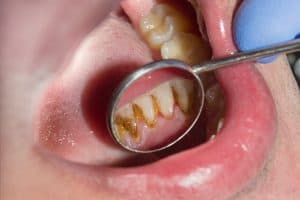Scale and Polish – What’s Involved in Tartar Removal?
 If you’ve ever been to your dentist and you’ve heard scale and polish services talked about, you may well have wondered what that was. Well, it’s the long way of saying tartar removal in order to prevent the onset of tooth decay and gum disease.
If you’ve ever been to your dentist and you’ve heard scale and polish services talked about, you may well have wondered what that was. Well, it’s the long way of saying tartar removal in order to prevent the onset of tooth decay and gum disease.
It’s a very common procedure, however, as 73% of UK adults are known to have tartar to some degree*. (*National Institute for Health & Care Excellence)
If you’re lucky enough never to have needed to have tartar removal carried out, then this article is for you. At Nutrident, we regularly publish blogs like this one, as you can see by visiting this link as we are dedicated to helping people enjoy great dental health and prevent tooth loss and gum issues. In this article, we look at the Scale & Polish procedure.
So, What Is Tartar & Why Does It Need to Be Removed?
Also known as ‘calculus’, tartar is something that builds up on the teeth when plaque is left in place and may harden. Made up of organic matter and bacteria, it’s much easier to see than plaque, as we often see it as a brown, black or yellow colour. The longer you wait for tartar removal, the darker it will become.
That’s not all that will happen if you don’t get your tartar removed either, as when left in place, it very often leads to:
- Halitosis
- Receding gums
- Gingivitis
- Tooth decay
- Tooth loss
On top of all this, it’s going to make your teeth look unsightly and possibly make you lose confidence in your smile. However, before it gets too bad, your family dentist will usually suggest you get your tartar seen during your regular six-month check-up.
Let’s have a look now at how tartar removal is carried out.
The Scale & Polish Process
The reason the scale and polish process needs to be carried out by a dentist is that tartar bonds tightly to the enamel on your teeth. You can’t simply scrape it away and it calls for the use of specialist dentistry tools and it involves two distinct steps.
Step One – Teeth Scaling
The first part of the job carried out by your dentist or a dental hygienist is the actual tartar removal part. Typically involving electric scaling equipment and a water spray to take the debris away, it can be a slightly unpleasant sensation as the tartar is lifted off.
Step Two – Teeth Polishing
The next step after the tartar is gone is the polishing stage, which makes the surface of your teeth nice and smooth. This really helps, as it eliminates any rough areas that are easier for tartar to get a hold of, as well as makes the appearance of your teeth better.
How Long is a Scale & Polish Treatment?
The treatment time varies from person to person, as each person’s tartar build-up is going to be slightly different, but you’re typically looking at anywhere from 15 to 45 minutes. Depending on your teeth sensitivity, your dentist or hygienist may offer a mild anaesthetic to help keep you comfortable.
The severity of the tartar removal procedure will depend on how long it has been left and how much it has built up. Should the tartar have affected the root below the gum line, it can still be dealt with by something known as root planing*.
(*NHS)
Keep on Top of Your Tartar With Regular Treatment
Tartar removal is an important part of most people’s dental health and you can either wait for your NHS dentist to suggest it or book a private appointment. The good news is that, like with all NHS dental treatment, it’s heavily subsidised, so will be classed as Band 2, which is currently at £62.10. Privately, you might pay as much as £100.
While we haven’t gone into intricate detail in this article, you should now have a much better idea about what tartar is and why removing is important. If you’re still unsure at your next appointment, why not have a chat about your tartar concern with your dentist? They will be able to offer advice on getting it done, as well as on preventative measures you can take to keep it away.
Either way, we hope you have found it super-useful and that it has given you enough knowledge to keep your and your family’s tartar under control.
References
Gingivitis and Periodontitis: How common is it? – Retrieved from: https://cks.nice.org.uk/topics/gingivitis-periodontitis/background-information/prevalence/
Gum disease treatment – Retrieved from: https://www.nhs.uk/conditions/gum-disease/treatment/
Frequently Asked Questions on tartar removal
Q: Can I remove tartar myself at home?
A: No, we wouldn’t recommend it. It requires knowledge and special equipment and you might end up causing yourself harm by attempting a DIY job.
Q: How long should I leave it between tartar removal treatments?
A: Your dentist will guide you, but it can be anywhere between every 6 months and every couple of years, depending on how quickly yours builds up.
Q: How is tartar different to plaque?
A: Well, plaque kind of is tartar. Plaque becomes tartar when it hardens.
Q: Are there any side effects from the procedure.
A: Not really, but if you have gum problems, they are likely to bleed.
————————————————————–
Author Bio

Gavin is a writer who specialises in creating informative articles on diet and oral health to help people achieve better all-round health.